A tented jungle paradise
By Swetha Amit | 17 Jul 2012
Living in tents and watching wild animals drink water a few feet away is an exciting prospect. A vacation in Africa enabled us to do just that, observe exotic fauna at close quarters. We landed in Nairobi and were escorted to our hotel rooms. Having time to spare, we decided to visit the highly-recommended restaurant ‘Carnivore’, which seemed to be popular among the locals as well.
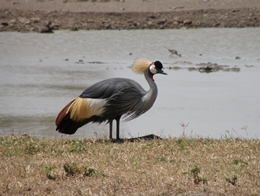 A meaty affair at the equator: Seated at cosy tables in dim-lit ambience, we could see lumps of meat being roasted on fire. Exotic sauces were served as accompaniments to the main course of meat of different species, which turned out to be an experiment for our tastebuds. Carnivore is bound to appeal to meat lovers and those open to trying out different cuisines. After an enjoyable evening, we drove down to Sweetwaters Tent Camp.
A meaty affair at the equator: Seated at cosy tables in dim-lit ambience, we could see lumps of meat being roasted on fire. Exotic sauces were served as accompaniments to the main course of meat of different species, which turned out to be an experiment for our tastebuds. Carnivore is bound to appeal to meat lovers and those open to trying out different cuisines. After an enjoyable evening, we drove down to Sweetwaters Tent Camp.
We stopped at the equator for a short while and witnessed an interesting display as to how the flow of water changes its course below and above the equator; after which we received a certificate stating that we had crossed the same. After clicking pictures, we headed out to our camp.
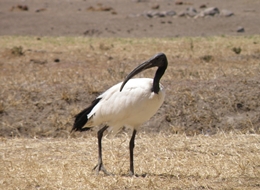 Tented rooms: Sweetwaters Tent Camp was situated amidst lush green surroundings. The tents which were our rooms faced a large pool of water where animals came to quench their thirst. As we explored the place, we spotted different species of animals and birds. The sacred ibis was one of them. They had white wings with black legs, head and neck. The crowned crane was spotted a few feet away with a dark grey body and a thick set of feathers on their crown.
Tented rooms: Sweetwaters Tent Camp was situated amidst lush green surroundings. The tents which were our rooms faced a large pool of water where animals came to quench their thirst. As we explored the place, we spotted different species of animals and birds. The sacred ibis was one of them. They had white wings with black legs, head and neck. The crowned crane was spotted a few feet away with a dark grey body and a thick set of feathers on their crown.
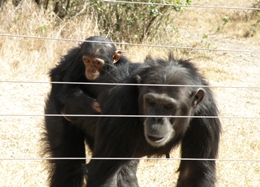 Getting acquainted with the chimps: Chimpanzees are usually found in the western part of the African continent. We were escorted to a viewing spot where the chimps would come in for their afternoon snack. They arrived in large numbers. What delighted us was that a couple of them were carrying their little ones. Separated by a barbed wire, they looked at us curiously. While they feasted on their snack, the guide explained about their lifestyle and dietary patterns. We then set out to explore the wilderness in our jeeps.
Getting acquainted with the chimps: Chimpanzees are usually found in the western part of the African continent. We were escorted to a viewing spot where the chimps would come in for their afternoon snack. They arrived in large numbers. What delighted us was that a couple of them were carrying their little ones. Separated by a barbed wire, they looked at us curiously. While they feasted on their snack, the guide explained about their lifestyle and dietary patterns. We then set out to explore the wilderness in our jeeps.
Jumbo trail: Our path crossed that of an elephant family. We halted our vehicles to observe a mother and little one feasting on leaves. All of a sudden, the mother turned towards us. She seemed wary and fearful, which prompted our guide to switch off the engine and sit still. The elephants gave us a glance over and crossed to the other side. We were told that “no noise and no movement” was the best way to reassure an animal of its safety. This was the first of the big five — the lion, leopard, rhino, elephant and wild buffalo — to be spotted by us.
Soaking in solitude: Venturing further into the jungle, we stumbled upon another of the big five. This was the wild buffalo, which usually moved in large groups. We were quite surprised to see this one standing alone. The guide narrated to us as to how these loners are considered outcasts due to their inability to keep pace with the herd as they grow old. We learnt that the twilight years were lonely ones for the wild buffalo as it were for humans now with an increase in nuclear families. With a sinking feeling, we left the beast to its own and drove further.
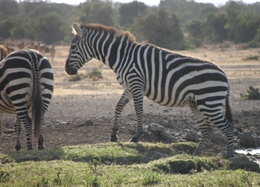 Zebra crossing with baboons and deers: A little ahead, we spotted some healthy zebras gorging themselves on grass, undisturbed by the group of riotous baboons that kept them company.
Zebra crossing with baboons and deers: A little ahead, we spotted some healthy zebras gorging themselves on grass, undisturbed by the group of riotous baboons that kept them company.
Going ahead, we were surprised and intrigued to know that there were several varieties in the deer and antelope family. Each of them was unique in appearance and habits. It was interesting to be introduced to them in their natural habitat. We spotted male impalas first. These were medium-sized antelopes, which were reddish brown in colour with white underbellies and lyre-shaped horns. The female impala had no horns.
As we drove down, we came across the male waterbuck. These were huge handsome antelopes. They had large, rounded ears and white patches above the eyes, around the nose and mouth and on the throat. Only the males have horns, which are prominently ringed and as long as 40 inches. We were told that contrary to their name; they were not aquatic by nature but would resort to waterbodies only while taking refuge from predators. The trip was becoming interesting by the minute as we got to learn about new specie.
The next in line was the male grant gazelle. These are noticeably larger and easily distinguished by the broad white patch on the rump that extends upward onto the back. They have a black stripe which runs along the thigh and possess lyre-shaped horns. After clicking a few pictures, we drove to our last stop for the day.
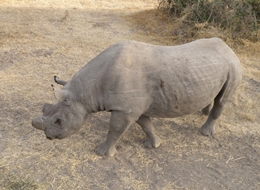 Locking horns with the rhino: We ended our day by locking horns with the rhino. We were told that there were two types, the black and the white rhino. To our surprise we did not find any difference in the colour as the name indicated. The black rhinos possess a hooked lip while the white were square-lipped.
Locking horns with the rhino: We ended our day by locking horns with the rhino. We were told that there were two types, the black and the white rhino. To our surprise we did not find any difference in the colour as the name indicated. The black rhinos possess a hooked lip while the white were square-lipped.
We visited the black rhino, which was called Barack much to our amusement. He seemed rather restless, pacing about furiously in his den. After taking a good look at him, we headed out to meet the white rhino; Marx was only four years old. He was fast asleep. Accompanied by two guards, we dared to cross the barbed fence to take a closer look at him and stroke his rough scaly skin. He was oblivious to what was happening around him even while we clicked pictures standing by his side. It was an unbelievable experience as we never thought in our wildest dreams that we would get a chance to pose with such a magnificent creature.
After an exciting evening we drove back to our tented rooms for the night. In a short span of time, we had learnt a lot about the African jungles. Sweetwaters Tented Camp is a must-visit for the opportunity to get a close view of chimpanzees and rhinos, without which a visit to Kenya would be incomplete.
How to get there
By road: Vehicles from Nairobi can take around two-three hours to reach the camp.
When to go
The best time of the year to visit Kenya is from July-September since wildlife migration from Tanzania gives ample opportunity to spot them in plenty. It is best to avoid the rainy season which falls during the months of April-May and November-December.
Cost of the tour
A two-day trip to Sweetwaters Tented Camp alone would cost around US$450 per person.
Guidelines
- Always be accompanied by a good guide.
- Adhere to your guide’s instructions and never get out of your vehicle.
- Game drives can get tiring. Make sure you carry plenty of water with you.
- Carry a SLR camera to capture wildlife from a distance.
- Do not make noises or talk loudly as to disturb or provoke an animal.






























